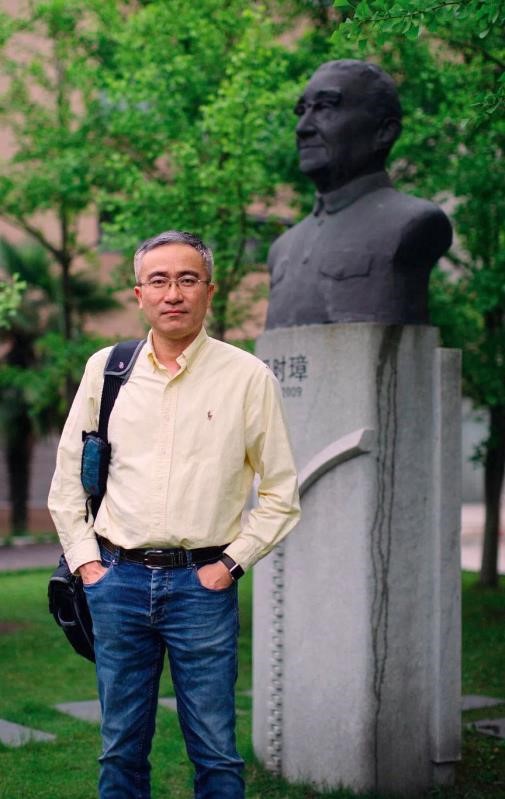
Tian Xue, PhD
EDUCATION AND RESEARCH EXPERIENCE
09/2012–present Professor, University of Science and Technology of China (USTC)
06/2011-08/2012 Research Associate, Johns Hopkins University School of Medicine
03/2006-05/2011 Postdoctoral Fellow (with Dr. King-Wai YAU) Johns Hopkins University School of Medicine, Neuroscience
09/2000-05/2005 Ph.D., Johns Hopkins University School of Medicine, Cellular & Molecular Physiology
09/1995-06/2000 B.S., University of Science and Technology of China (USTC), Biophysics and Neuroscience; Special Class for Gifted Young (SCGY)
HONORS AND AWARDS
2003 American Heart Association (AHA) Scientific Sessions Selected Late-Breaking Science
2004 NIH Stem Cells Scholarship at the Keystone Stem Cells Symposium, NIH
2006 BEST BASIC SCIENCE PAPER by Circulation, AHA
2007 Final list of Life Science Research Foundation Fellowships
2012 Outstanding Youth Science Foundation ,NSFC
2014 Human Frontier Science Program (HFSP),Young Investigator Grants
RESEARCH INTERESTS
Responding to the surrounding environment is one of the vital traits of a living organism. In particular sensing light is a most important perception and way of gathering information for most organisms. Dr. XUE’s lab is hence interested in understanding physiological characteristics and signaling mechanisms of photo-sensation, revealing neural circuits involved in this process and exploring methods for vision restoration after photoreceptor degeneration. “Light” does not only convey image information (image-forming vision), but also has impact on a number of physiological functions, such as light-entrainment of circadian rhythm, mood regulation, sleep, negative masking, pupillary light reflex, melatonin secretion etc. – functions referred to collectively as non-image vision (NIV). Only until recently, we realized that NIV is mediated by a special group of light-responsive cells in the retina: intrinsically photo-sensitive retinal ganglion cells (ipRGCs).
1. Neuronal Circuitry Involved in NIV
As compared to classic image-forming vision, we have very limited knowledge regarding the neuronal circuits involved in NIV. On-going projects in Dr. Xue’s lab focus on the mesoscopic structure and function of NIV-associated neuronal circuitry, using techniques such as trans-synaptic viral tracing, electrophysiology, optogenetics, and in vivo deep-brain calcium imaging.
2. Vision Rescue
Perception of light is of great importance, thus restoration of damaged photoreception (especially blindness caused by degeneration of rods and cones) is of high clinical value. One direction of Dr.XUE’s lab is to explore the possibilities in vision repair and rescue with a combinatorial approach employing stem cell regeneration, gene editing, and bio-informatics.
3. Photo-transduction Mechanisms and Neuronal Coding Underlying NIV
It is still not fully clear how ipRGCs control the unique kinetics of its light response through photo-transduction mechanisms, and what physiological significance this has for neuronal coding of NIV. We aim to investigate molecular targets that may affect the kinetics of ipRGC-mediated photo-responses, with the aid of transgenic mice, AAV-RNAi, patch-clamp and optogenetic techniques. We will further combine in vivo optogenetics with behavioral tests to reveal the coding pattern of ipRGC-mediated information, and its impact on NIV-associated physiological processes. This will expand our understanding about the strategy used by neural systems to code environmental stimuli for different physiological needs.
REPRESENTATIVE PUBLICATIONS
1.Ma Y#, Bao J#*, Zhang Y#, Li Z, Zhou Z, Zhou X, Wan C, Huang L, Zhao Y, Han G*, XueT*.
Injectable, Self-powered Retinal Nanoantennae for the Creation of Mammalian Near-infrared Image
Vision. Cell, 177, 1-13, 2019 (*co-corresponding authors lead contact)
2.Cai Y#, Cheng T#, Yao Y#, Li X, Ma Y, Li L, Zhao H, Bao J, Zhang M*, Qiu Z*, Xue T*In vivo
genome editing rescues photoreceptor degeneration via a Cas9/RecA-mediated homology-directed
repair pathway. Science Advances, Accepted (*co-corresponding authors lead contact)
3.Yu N, Huang L, Zhou Y*, Xue T*, Chen Z*, and Han G* (2019). Near-Infrared-Light Activatable
Nanoparticles for Deep-Tissue-Penetrating Wireless Optogenetics. Adv Healthc Mater, e1801132.
(*co-corresponding authors)
4.Zhu H#;Wang N#;Yao L; Chen Q; Zhang R; Qian J; Hou Y; Guo W; Fan S;Liu S; Zhao Q; Du F; Zuo
X; Guo Y; Xu Y; Li J; Xue T; Zhong K; Song X; Huang G*;Xiong W*. Moderate UV exposure enhances
learning and memory by promoting a novel glutamate biosynthetic pathway in the brain.
Cell 173, 1716-1727 e1717. (2018)
5.Ye F, Huang Y, Li J, Ma Y, Xie C, Liu Z, Deng X, Wan J, Xue T, Liu W, Zhang M(2018). An
unexpected INAD PDZ tandem-mediated plcbeta binding in Drosophila photo receptors. Elife 7.
6.Deng K, Shen J, Wang W, Li M, Li H, Chen C, Zhao H, Zhang M, Xue T, Liu Q, Lui VWY, Hong B,
Lin W. Sodium chloride (NaCl) potentiates digoxin-induced anti-tumor activity in small cell
lung cancer. Cancer Biol Ther. 2018 Sep 5:1-13.
7.Deng WL, Gao ML, Lei XL, Lv JN, Zhao H, He KW, Xia XX, Li LY, Chen YC, Li YP, Pan D, Xue T,
Jin, Z. B. Gene Correction Reverses Ciliopathy and Photoreceptor Loss in iPSC-Derived Retinal
Organoids from Retinitis Pigmentosa Patients. Stem Cell Reports 2018, 10(4):1267-1281.
8.Tang J, Qin N, Chong Y, Diao Y, Yiliguma, Wang Z, Xue T, Jiang M, Zhang J,Zheng G: Nanowire
arrays restore vision in blind mice. Nat Commun 2018, 9(1):786.
9.Cheng J, Huang X, Liang Y, Xue T, Wang L, Bao J: Plasticity of Light-induced concurrent
Glutamatergic and GABAergic Quantal Events in the Suprachiasmatic Nucleus. J Biol Rhythms 2018, 33(1):65-75.
10.Li Q, Cui M, Yang F, Li N, Jiang B, Yu Z, Zhang D, Wang Y, Zhu X, Hu H, Li PS, Ning SL, Wang S, Qi H, Song H, He D, Lin A, Zhang J, Liu F, Zhao J, Gao L, Yi F, Xue T, Sun JP, Gong Y, Yu X. (2017) A cullin 4B-RING E3 ligase complex fine-tunes pancreatic δ cell paracrine interactions. J Clin Invest. 127(7):2631-2646.
Website:http://www.xuelab.ustc.edu.cn/
E-mail: Xuetian@ustc.edu.cn
Phone:0551-63600967